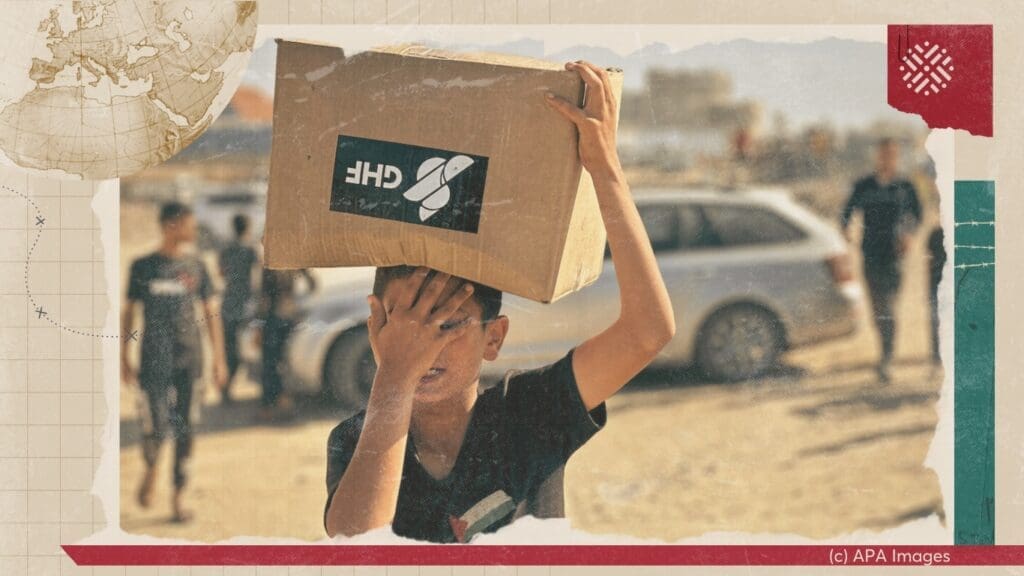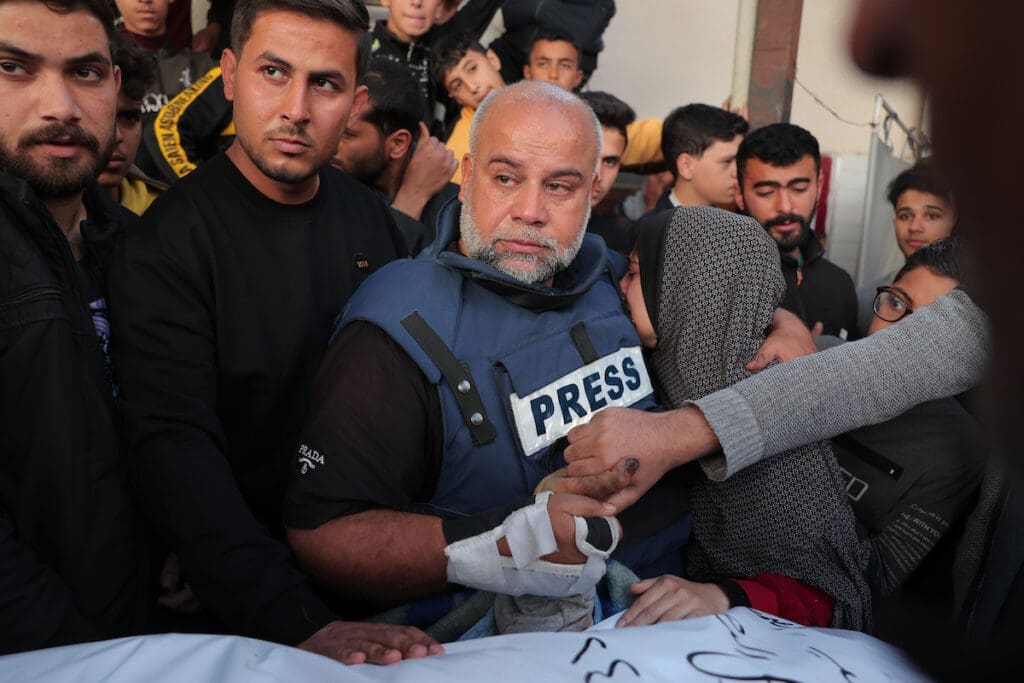- Topics
-
Topics
See our analysis on civil society and how it shapes culture, politics, and policies
Read our insights on the shifting political landscape and what it means for Palestine
Learn more about the policies and practices shaping the Palestinian economy
Strengthen your understanding of the unique conditions for Palestinian refugees across the Middle East
-
- Analysis
-
Analysis
In-depth analysis on existing or potential policies that impact possibilities for Palestinian liberation.
Insights and perspectives on social, political, and economic questions related to Palestine and Palestinians globally.
Concise analysis into a specific policy, its background and implications.
Commentary that brings together insights from multiple analysts.
Compilations of past Al-Shabaka works surrounding a specific theme.
Longer-form, ad hoc projects that seek to confront research questions outside the scope of our regular analysis.
A policy-driven research initiative by Al-Shabaka: The Palestinian Policy Network.
Our monthly webinar series that brings together Palestinian experts.
Featured
On Thursday, June 19, 2025, Israeli Prime Minister Benjamin Netanyahu stood in front of the aftermath of an Iranian strike near Bir al-Saba’ and told journalists: “It really reminds me of the British people during the Blitz. We are going through a Blitz.” The Blitz refers to the sustained bombing campaign carried out by Nazi Germany against the UK, particularly London, between September 1940 and May 1941. With this dramatic comparison, Netanyahu sought to elicit Western sympathy and secure unconditional support for his government’s latest act of military escalation and violation of international law: the unprovoked bombing of Iran. This rhetorical move is far from new; it has become an enduring trope in Israeli political discourse—one that casts Israel as the perennial victim and frames its opponents as modern-day Nazis. Netanyahu has long harbored ambitions of striking Iran with direct US support, but timing has always been central. This moment, then, should not be viewed merely as opportunistic aggression, but as part of a broader, calculated strategy. His actions are shaped by a convergence of unprecedented impunity, shifting regional dynamics, and deepening domestic political fragility. This commentary examines the latest escalation in that context and discusses the broader political forces driving it. Yara Hawari· Jun 26, 2025Launched on May 26, 2025, and secured by US private contractors, the new Israeli-backed aid distribution system in Gaza has resulted in over 100 Palestinian deaths, as civilians navigated dangerous conditions at hubs positioned near military outposts along the Rafah border. These fatalities raise grave concerns about the safety of the aid model and the role of US contractors operating under Israeli oversight. This policy memo argues that the privatization of aid and security in Gaza violates humanitarian norms by turning aid into a tool of control, ethnic cleansing, and colonization. It threatens Palestinian life by conditioning life-saving aid, facilitating forced displacement, and shielding the Israeli regime from legal and moral responsibility. It additionally erodes local and international institutions, especially UNRWA, which has been working in Gaza for decades.
Yara Hawari· Jun 26, 2025Launched on May 26, 2025, and secured by US private contractors, the new Israeli-backed aid distribution system in Gaza has resulted in over 100 Palestinian deaths, as civilians navigated dangerous conditions at hubs positioned near military outposts along the Rafah border. These fatalities raise grave concerns about the safety of the aid model and the role of US contractors operating under Israeli oversight. This policy memo argues that the privatization of aid and security in Gaza violates humanitarian norms by turning aid into a tool of control, ethnic cleansing, and colonization. It threatens Palestinian life by conditioning life-saving aid, facilitating forced displacement, and shielding the Israeli regime from legal and moral responsibility. It additionally erodes local and international institutions, especially UNRWA, which has been working in Gaza for decades. Safa Joudeh· Jun 10, 2025In this policy lab, Mariam Barghouti and Sharif Abdel Kouddous join host Tariq Kenney-Shawa to discuss Israel’s targeted assassination campaign against Palestinian journalists, the complicity of Western media in normalizing these crimes, and how this silence allows Israel to get away with genocide.
Safa Joudeh· Jun 10, 2025In this policy lab, Mariam Barghouti and Sharif Abdel Kouddous join host Tariq Kenney-Shawa to discuss Israel’s targeted assassination campaign against Palestinian journalists, the complicity of Western media in normalizing these crimes, and how this silence allows Israel to get away with genocide. Mariam Barghouti· May 28, 2025
Mariam Barghouti· May 28, 2025
-
- Resources
- Media & Outreach
- The Network




The Dangers of Disaggregating Sovereignty
Introduction
Israel’s position towards Palestinian sovereignty has remained relatively consistent since its first policy formulation in the 1970s: no sovereignty over the land but limited control over the population. Despite an occasional statement by an outgoing prime minister that Israel did not wish to “control” the Palestinians indefinitely, it espoused the notion of Palestinian “autonomous” but not independent areas on some, but not all, of the lands occupied in 1967.
As noted by Camille Mansour in his Policy Brief, “How Sovereign a State?,” the elements of sovereignty entail control over land, territorial waters, borders, natural resources, and population. Facing external pressure to negotiate with the Palestinians, Israel’s strategy was designed to ensure that these elements of sovereignty remained unaddressed and that it retained control over the Palestinians and their lands. From the limited jurisdiction accorded to the Palestinian Authority (PA), on to the PA’s inability to enter into trade or other international agreements, and down to the minutiae of referring to the PA head as “Ra’is” rather than president, Israel’s strategy has been to focus on and develop the option of limited Palestinian self-rule.
The Halfway “State”
Throughout the negotiations, Israel’s approach has been to disaggregate the components of sovereignty, negotiate “compromise” over them, and then argue that the essential elements of sovereignty (and hence statehood) are not present. The Oslo Accords between the Palestine Liberation Organization (PLO) and Israel delineated the various “permanent status” issues requiring further negotiations. The six permanent status issues neatly break down to cover the elements of sovereignty: refugees (control over people), security, borders, settlements, water (control over territory and natural resources), and Jerusalem (embodying a combination of control over territory and over population). In his book, The Missing Peace, Dennis Ross boasts of his efforts to convince Israel about Palestinian statehood and acknowledges that the outcome of the years of Palestinian-Israeli negotiations was not statehood and sovereignty for Palestinians but some other construct between occupied territory and statehood.
During the 1990s, this middle ground – the creation of an entity that can be classified neither as a sovereign state nor as occupied territory – continued to take shape. As late as 2000 and 2001, during the final round of Israeli-Palestinian negotiations, Israel still envisaged limited sovereignty over the West Bank and Gaza Strip. During the final rounds of negotiations at Taba, Israel demanded five early warning stations in the West Bank – lands that would be under Israel’s control for surveillance over Palestinians. It thereby ensured that an essential element of sovereignty – control over land – would remain under a foreign state. Palestinians would have a non-militarized entity, with limited defense capabilities. Israel would continue to control natural resources, borders as well as economic and diplomatic relations with foreign states.
Although Israel said at Taba that it would relinquish control over the Gaza Strip, it continued to insist on control over territorial waters and airspace in the name of “security.” The “safe passage” between the West Bank and the Gaza Strip was to be under Israel’s control and supervision, but allotted in terms of land percentages to the future Palestinian entity. And, while little progress was made over the issue of Palestinian refugees, Israel refused to allow unlimited immigration/entry into the future Palestinian entity. Indeed, the very word “state” was something that Israeli negotiators refused to enunciate.
The Lessons of Gaza
Israel’s approach to Palestinian sovereignty is best demonstrated in the period following its unilateral evacuation from the Gaza Strip. As was its approach during bilateral negotiations, Israel retained essential elements of sovereignty after its pullout, while also arguing that a new international standard be developed to cover an entity that is no longer considered to be occupied yet lacks the elements of full sovereignty (somewhat akin to the Bantustans of South Africa that only the apartheid government of South Africa recognized as being states).
Israel’s unilateral evacuation of its colonies from the Gaza Strip was accompanied by continued control over Palestinian borders (indirectly), imports and exports, territorial waters, airspace, and the population registry. The latter item is of particular significance as it enables Israel to continue to determine who is entitled to enter, exit, and remain in the occupied Palestinian territories. Although Israel continues to control the Gaza Strip, it argues that the area is no longer occupied. The Israeli Supreme Court decided that the area is no longer occupied under international law, but Israeli attempts to pass a UN resolution to this effect have yet to succeed. However, should the PLO decide, under pressure of bilateral negotiations, to accept the formation of a “statelet” rather than a sovereign state then it is likely that the international community would also accept it.
Yet while Israel can and must be held to account for its desire to perpetuate its control over the Palestinians and their land, so too must the PLO be criticized for falling into the trap of approaching negotiations in a piecemeal fashion and sticking to the six pre-defined issues without looking at the broader implications of Israel’s strategy of disaggregating the components of sovereignty. By accepting to approach the negotiations process in such a manner, the PLO communicated that “compromise” could be reached on essential elements of sovereignty. Palestinian negotiators must also be heavily criticized for buying into and continuing to hold onto a failed process that seeks to grant Palestinians little more than a statelet without real sovereignty. The experience following Israel’s unilateral evacuation from the Gaza Strip sheds light on its future plans for the West Bank. It is hoped that Palestinian negotiators will learn from their experience of negotiations with Israel and realize that the sum of the disaggregated parts can never be greater than the whole.
Diana Buttu
Latest Analysis
Timed for Impunity: Israel’s War on Iran
Outsourcing Occupation: US Private Contractors in Gaza
Israel’s War on Palestinian Journalists
We’re building a network for liberation.
As the only global Palestinian think tank, we’re working hard to respond to rapid developments affecting Palestinians, while remaining committed to shedding light on issues that may otherwise be overlooked.